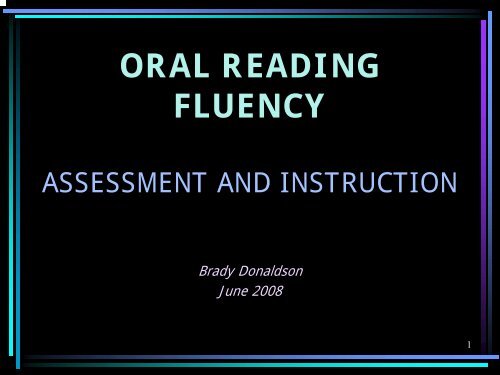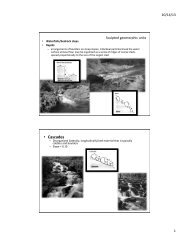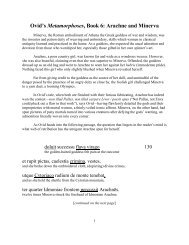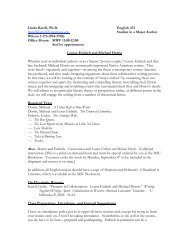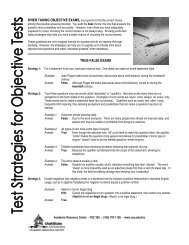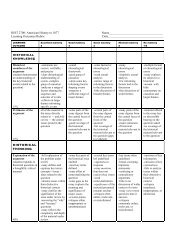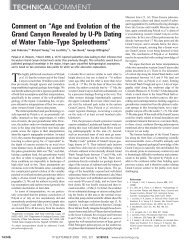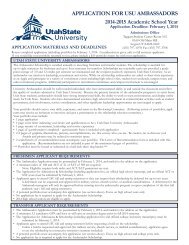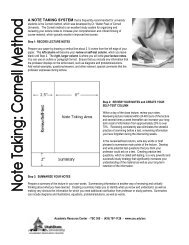Oral Reading Fluency Assessment and Instruction
Oral Reading Fluency Assessment and Instruction
Oral Reading Fluency Assessment and Instruction
You also want an ePaper? Increase the reach of your titles
YUMPU automatically turns print PDFs into web optimized ePapers that Google loves.
ORAL READING<br />
FLUENCY<br />
ASSESSMENT AND INSTRUCTION<br />
Brady Donaldson<br />
June 2008<br />
1
FLUENCY<br />
“The Sleeping Giant”<br />
2
AUTOMATICITY<br />
LaBerge & Samuels, 1974<br />
• <strong>Reading</strong> words with no noticeable<br />
cognitive or mental effort.<br />
• Master word recognition skills to the<br />
point of over learning.<br />
• Other Examples<br />
– Shifting gears on a car<br />
– Playing a musical instrument<br />
– Playing a sport (serving a tennis ball)<br />
3
READING PROCESS<br />
• Word recognition<br />
• Accessing word meaning<br />
• Decide on correct meaning<br />
• Group words into grammatical units<br />
• Generate inferences<br />
• Construct coherent, underst<strong>and</strong>able<br />
model of text<br />
-S. Jay Samuels<br />
4
WHAT IS READING FLUENCY?<br />
• Speed<br />
• Accuracy<br />
• Expression<br />
• Comprehension<br />
*The latest conceptualizations of fluency have extended<br />
beyond word recognition processes <strong>and</strong> now include<br />
comprehension processes.<br />
-Thurlow & van den Broek<br />
5
WHAT IS READING FLUENCY?<br />
• Combination of accuracy <strong>and</strong><br />
automaticity.<br />
• Expression (features of prosody)<br />
– Pitch<br />
– Pausing <strong>and</strong> phrasing<br />
– Stress<br />
• Consider punctuation<br />
6
WHAT IS READING FLUENCY?<br />
• <strong>Fluency</strong> is not an end in itself but a critical<br />
gateway to comprehension.<br />
• Fluent reading frees resources to process<br />
meaning.<br />
– Ability to perform multiple tasks-such as word<br />
recognition <strong>and</strong> comprehension – at the same<br />
time.<br />
– If word recognition is difficult, cognitive resources<br />
are consumed <strong>and</strong> slow the reading process.<br />
7
“NON-FLUENCY”<br />
• Signs of a non-fluent reader<br />
– If listening comprehension is better than<br />
reading comprehension<br />
– If oral rate of reading (below 60 wpm)<br />
– Below 90% accuracy<br />
– Poor expression<br />
8
Successful readers…<br />
• Rely primarily on the letters<br />
• Process virtually every letter<br />
• Use letter-sound correspondences<br />
• Decode words strategically<br />
• Practice ‘till automatic<br />
9
ASSESSING ORAL READING<br />
• Components<br />
– Speed<br />
– Accuracy<br />
– Expression<br />
– Comprehension<br />
• Measures:<br />
– <strong>Oral</strong> <strong>Reading</strong> <strong>Fluency</strong> (ORF)<br />
– Running Records<br />
10
ASSESSING ORAL READING<br />
• Note during oral reading:<br />
– <strong>Oral</strong> word recognition errors<br />
– WCPM rate<br />
– <strong>Oral</strong> reading expression<br />
– Comprehension<br />
11
PURPOSE OF RUNNING RECORDS<br />
• Developed for <strong>Reading</strong> Recovery<br />
• Purposes:<br />
– Monitor student progress<br />
– Identify skills <strong>and</strong> strategies used by<br />
student while reading<br />
– Focus on needs<br />
– Grouping purposes<br />
– Selecting books according to levels<br />
12
1. Select text<br />
TAKING THE RECORD<br />
2. Child sits beside teacher<br />
3. Read title<br />
4. Child reads book while teacher notes<br />
student reading behavior on paper<br />
(copy of text may be helpful)<br />
13
TAKING THE RECORD<br />
5. Errors<br />
• Substitutions<br />
• Omissions<br />
• Deletions<br />
• Told word<br />
6. Non-errors<br />
– Hesitations<br />
– Repetitions<br />
– Self-corrections<br />
T Told<br />
SC Self-correct<br />
- Skipped word<br />
^ Inserted word<br />
TTA Try that again<br />
R Repetition<br />
W Wait (hesitation)<br />
A Appeal<br />
14
• Accuracy:<br />
SCORING<br />
Total words/Correct words<br />
95%-100% Independent<br />
90% - 94% <strong>Instruction</strong>al<br />
89% <strong>and</strong> below Frustrational<br />
• SC Ratio:<br />
(# of errors + # SC) / SC<br />
15
TAKING THE RECORD<br />
5. Allow time for problem solving<br />
6. Calculate accuracy, error ratio, s.c. ratio<br />
7. Analyze notes to identify reading behavior<br />
patterns)<br />
16
VIDEO<br />
• View video <strong>and</strong> note student’s reading<br />
behavior<br />
• Determine what the student is <strong>and</strong> is<br />
NOT doing<br />
• Analyze notes<br />
• Describe instructional plans for the<br />
student<br />
17
ORAL READING FLUENCY (ORF)<br />
• Curriculum Based Measures (Deno,<br />
1985)<br />
• Efficiently administered 1 on 1<br />
• Assesses rate <strong>and</strong> accuracy<br />
• Scores compared to norms<br />
• High correlation to reading achievement<br />
<strong>and</strong> comprehension<br />
18
DIBELS <strong>Oral</strong> <strong>Reading</strong> <strong>Fluency</strong><br />
Beg Mid End Beg Mid End Beg Mid End Beg Mid End Beg Mid<br />
Preschool Kindergarten First Grade Second Grade Third Grade<br />
DIBELS <strong>Oral</strong> <strong>Reading</strong> <strong>Fluency</strong><br />
• DIBELS <strong>Oral</strong> <strong>Reading</strong> <strong>Fluency</strong> is intended for most<br />
children from mid first grade through sixth-grade.<br />
The benchmark goals are 40 in spring of first grade,<br />
90 in spring of second grade, <strong>and</strong> 110 in the spring<br />
of third grade.<br />
• Students may need intensive instructional support if<br />
they score below 10 in spring of first grade, 50 in<br />
spring of second grade, <strong>and</strong> 70 in spring of third<br />
grade.<br />
19
Materials<br />
• Student copy of passage<br />
• examiner copy<br />
• Clipboard<br />
• Stopwatch<br />
• colored scoring pen<br />
20
Directions for Administration<br />
1. Place the reading passage in front of the<br />
student.<br />
2. Place the examiner copy on clipboard <strong>and</strong><br />
position so that the student cannot see what<br />
you record.<br />
21
Directions<br />
Dynamic Indicators of Basic Early Literacy Skills<br />
University of Oregon<br />
First Grade Benchmark 2 – DIBELS <strong>Oral</strong> <strong>Reading</strong> <strong>Fluency</strong>, Passage 1<br />
The Robin’s Nest<br />
There was a robin’s nest outside our kitchen window. The<br />
nest was in a tall bush. The mother robin sat in the nest all day<br />
long. One day when I was watching, the mother bird flew<br />
away. I saw the eggs she was sitting on. There were four blue<br />
eggs.<br />
I watched <strong>and</strong> watched. The eggs moved. I watched some<br />
more. The eggs started to crack. Finally, the eggs hatched. I<br />
saw four baby birds. The baby birds opened their beaks wide.<br />
I heard them peeping. Soon the mother bird came back. Then<br />
the mother robin put worms in their mouths.<br />
Every day I watched the baby birds <strong>and</strong> their mother.<br />
Pretty soon the babies were so fat there was no room for the<br />
mother. Then one morning the nest was gone from the bush.<br />
© 2001 Good & Kaminski Page 6<br />
3. Say these specific<br />
directions to the<br />
student:<br />
Please read this (point)<br />
out loud. If you get<br />
stuck, I will tell you<br />
the word so you can<br />
keep reading. When I<br />
say, “stop” I may ask<br />
you to tell me about<br />
what you read, so do<br />
your best reading.<br />
Start here (point to the<br />
first word of the<br />
passage). Begin.<br />
22
Timing<br />
4. Start your stopwatch when the student says the<br />
first word of the passage. The title is not counted. If<br />
the student fails to say the first word after 3 seconds,<br />
tell them the word <strong>and</strong> mark it as incorrect, then<br />
start your stopwatch.<br />
5. The maximum time for each word is 3 seconds. If<br />
the student does not provide the word within 3<br />
seconds, say the word <strong>and</strong> mark the word as<br />
incorrect.<br />
6. Follow along on the examiner copy of the probe. Put<br />
a slash ( ) over words read incorrectly.<br />
23
Scoring<br />
7. At the end of 1 minute, place a<br />
bracket ( ] ) after the last word<br />
provided by the student <strong>and</strong> say “Stop”<br />
<strong>and</strong> remove the passage.<br />
8. Choose whether to administer the<br />
optional Retell <strong>Fluency</strong> Measure.<br />
24
Directions for Scoring<br />
1. Score reading passages immediately after<br />
administration.<br />
2. Discontinue Rule. If the student does not read any<br />
words correctly in the first row, discontinue the task<br />
<strong>and</strong> record a score of 0.<br />
3. Record the total number of words read correctly on the<br />
bottom of the scoring sheet for each passage.<br />
4. If the student reads fewer than 10 words correct on the<br />
first passage, record their score on the front cover <strong>and</strong><br />
do not administer passages 2 <strong>and</strong> 3.<br />
5. If the student reads 3 passages, record their middle<br />
score on the front cover. For example, if the student<br />
gets scores of 27, 36, <strong>and</strong> 25, record a score of 27 on<br />
the front cover.<br />
25
Directions for Scoring<br />
6. Hesitate or struggle with words. If a<br />
student hesitates or struggles with a<br />
word for 3 seconds, tell the student the<br />
word <strong>and</strong> mark the word as incorrect.<br />
If necessary, indicate for the student to<br />
continue with the next word.<br />
Passage<br />
Student Says<br />
Scoring<br />
Procedure<br />
Correct Words<br />
/ Total Words<br />
I have a goldfish. “I have a …<br />
(3 seconds)”<br />
I have a goldfish. 3 /4<br />
26
Hyphenated words<br />
7. Hyphenated words. Hyphenated words<br />
count as two words if both parts can st<strong>and</strong><br />
alone as individual words. Hyphenated words<br />
count as one word if either part cannot st<strong>and</strong><br />
alone as an individual word.<br />
Passage<br />
Number of<br />
Words<br />
I gave Ben a red yo-yo.<br />
We did push-ups, pull-ups, <strong>and</strong> sit-ups.<br />
6<br />
9<br />
27
Numerals<br />
8. Numerals. Numerals must be read<br />
correctly in the context of the sentence.<br />
Passage<br />
Student Says<br />
Scoring<br />
Procedure<br />
Correct Words<br />
/ Total Words<br />
My father is 36.<br />
“My father is thirty-six.”<br />
My father is 36.<br />
4 /4<br />
My father is 36.<br />
“My father is three six.”<br />
My father is 36.<br />
3 /4<br />
I am 6 years<br />
old.<br />
“I am six years old.”<br />
I am 6 years old.<br />
5 /5<br />
28
Mispronounced words<br />
9. Mispronounced words. A word is scored as correct<br />
if it is pronounced correctly in the context of the<br />
sentence. If the word is mispronounced in the<br />
context, it is scored as an error.<br />
Passage Student Says Scoring Procedure<br />
Dad read the paper.<br />
“Dad reed the paper.”<br />
(i.e., long e)<br />
Dad read the paper.<br />
Correct Words<br />
/ Total Words<br />
3 /4<br />
I ate too much.<br />
“I eat too much.”<br />
I ate too much.<br />
3 /4<br />
29
Self Corrections<br />
10. Self Corrections. A word is scored as<br />
correct if it is initially mispronounced but the<br />
student self corrects within 3 seconds. Mark<br />
SC above the word <strong>and</strong> score as correct.<br />
Passage<br />
Dad read the<br />
paper.<br />
Student Says<br />
“Dad reed … red the<br />
paper.” (i.e., selfcorrects<br />
to short e)<br />
Scoring<br />
Procedure<br />
SC<br />
Dad read the<br />
paper.<br />
Correct Words<br />
/ Total Words<br />
4 /4<br />
30
Repeated Words<br />
11. Repeated Words. Words that are<br />
repeated are not scored as incorrect<br />
<strong>and</strong> are ignored in scoring.<br />
Passage<br />
Student Says<br />
Scoring<br />
Procedure<br />
Correct Words<br />
/ Total Words<br />
I have a goldfish.<br />
“I have a … I<br />
have a goldfish.”<br />
I have a goldfish. 4 /4<br />
31
Articulation <strong>and</strong> Dialect<br />
12. Articulation <strong>and</strong> dialect. The student is not penalized for<br />
imperfect pronunciation due to dialect, articulation, or second<br />
language interference. For example, if the student consistently<br />
says /th/ for /s/, <strong>and</strong> reads “rest” as “retht,” he or she should be<br />
given credit for a correct word. This is a professional judgment<br />
<strong>and</strong> should be based on the student’s responses <strong>and</strong> any prior<br />
knowledge of his/her speech patterns.<br />
Passage Student Says Scoring Procedure<br />
Correct Words<br />
/ Total Words<br />
It is time for<br />
a rest.<br />
“It is time for a retht.”<br />
(articulation)<br />
It is time for a rest.<br />
6 /6<br />
We took the<br />
short cut.<br />
“We took the shot cut.”<br />
(dialect)<br />
We took the short<br />
cut.<br />
5 /5<br />
32
Inserted Words<br />
13. Inserted words. Inserted words are ignored <strong>and</strong><br />
not counted as errors. The student also does not get<br />
additional credit for inserted words. If the student<br />
frequently inserts extra words, note the pattern at<br />
the bottom of the scoring page.<br />
Passage Student Says Scoring Procedure<br />
Correct Words<br />
/ Total Words<br />
It is time for<br />
a rest.<br />
“It is time for a<br />
long rest.”<br />
It is time for a rest.<br />
6 /6<br />
I ate too<br />
much.<br />
“I ate way too<br />
much.”<br />
I ate too much.<br />
4 /4<br />
33
Omitted Words<br />
14. Omitted words. Omitted words are<br />
scored as incorrect.<br />
Passage Student Says Scoring Procedure<br />
Correct Words<br />
/ Total Words<br />
It is time for a<br />
“It is time for<br />
It is time for a rest.<br />
5 /6<br />
rest.<br />
rest.”<br />
I ate too<br />
much.<br />
“I ate much.”<br />
I ate too much.<br />
3 /4<br />
34
Word Order<br />
15. Word Order. All words that are read<br />
correctly but in the wrong order are<br />
scored as incorrect.<br />
Passage Student Says Scoring Procedure<br />
Correct Words<br />
/ Total Words<br />
The ice cream<br />
“The cream ice<br />
The ice cream man comes.<br />
3 /5<br />
man comes.<br />
man comes.”<br />
I ate too much.<br />
“I too ate much.”<br />
I ate too much.<br />
2 /4<br />
35
Abbreviations<br />
16. Abbreviations. Abbreviations should be read in the<br />
way you would normally pronounce the abbreviation<br />
in conversation. For example, TV could be read as<br />
“teevee” or “television” but Mr. would be read as<br />
“mister.”<br />
Passage Student Says Scoring Procedure<br />
May I watch TV?<br />
May I watch TV?<br />
My teacher is Mr.<br />
Smith.<br />
My teacher is Mr.<br />
Smith.<br />
“May I watch<br />
teevee?”<br />
“May I watch<br />
television?”<br />
“My teacher is<br />
mister Smith.”<br />
“My teacher is<br />
‘m’ ‘r’ Smith.”<br />
May I watch TV?<br />
May I watch TV?<br />
My teacher is Mr. Smith.<br />
My teacher is Mr. Smith.<br />
Correct Words<br />
/ Total Words<br />
4 /4<br />
4 /4<br />
5 /5<br />
4 /5<br />
36
PRACTICE WITH VIDEO<br />
37
THE BEST OF BOTH WORLDS<br />
RUNNING RECORDS<br />
• On the run-any text<br />
• Identifies multiple<br />
strategies used <strong>and</strong><br />
NOT used by<br />
student.<br />
• Administration time<br />
• In-depth training to<br />
interpret information<br />
• Low reliability<br />
• Quick<br />
ORF<br />
• Easy administration<br />
• Report system<br />
• Just a slice<br />
• Teach what is<br />
tested-less focus on<br />
comprehension<br />
38
Dynamic <strong>Oral</strong> <strong>Reading</strong> Check<br />
DORC<br />
• Text aligned with instruction<br />
• Accuracy<br />
• <strong>Reading</strong> rate<br />
– (Time in seconds / words correct X 60 = wcpm)<br />
• Strategies in place<br />
• Error patterns<br />
• Note expressiveness<br />
• Check for underst<strong>and</strong>ing<br />
– Retelling or ask questions<br />
39
EFFECTIVE INSTRUCTION<br />
• Well planned guided oral reading instruction<br />
– Teacher modeling<br />
– Direct instruction with feedback<br />
– Phrasing practice<br />
– Comprehension component<br />
• Repeated reading <strong>and</strong> wide reading is better<br />
than no reading<br />
• Students need many opportunities to read<br />
appropriately difficult text (Rasinski)<br />
40
FLUENCY INSTRUCTION<br />
• Effective fluency building instruction<br />
rests on three critical decisions:<br />
– Selecting appropriate instructional tasks<br />
– Scheduling sufficient practice (multiple<br />
opportunities per day).<br />
– Systematically increasing the rate of<br />
response.<br />
41
WORD RECOGNITION<br />
• To build fluency, text needs to contain<br />
words previously taught as…<br />
– High Frequency words<br />
– Sequentially decodable words<br />
– Words with known phonograms<br />
42
WORD RECOGNITION<br />
• Primer Level- First 100 words<br />
– Students who do not master the first 100<br />
words until grade three tend not to<br />
become good readers<br />
• Third grade students need to rapidly<br />
recognize the first 5,000 words<br />
43
INTERVENTIONS<br />
• <strong>Reading</strong> fluency lessons<br />
• Independent reading<br />
• Teacher, peer, <strong>and</strong> technology assisted<br />
readings<br />
• <strong>Reading</strong> for performance<br />
• Family/home programs<br />
44
• Format:<br />
FLUENCY INSTRUCTION<br />
– Teacher reads content area text<br />
– Discussion of text<br />
– Students read text orally –multiple settings <strong>and</strong><br />
times<br />
• <strong>Fluency</strong> Oriented <strong>Reading</strong> <strong>Instruction</strong> (FORI)<br />
• Wide <strong>Reading</strong> (WR)<br />
• <strong>Fluency</strong> Development Lesson (FDL)<br />
• Shared Book Experience (SBE)<br />
45
INDEPENDENT READING<br />
• <strong>Reading</strong> independently in class is<br />
better than NO reading in class.<br />
46
ASSISTED ORAL READING<br />
PRACTICE WITH FEEDBACK<br />
• Guided <strong>Oral</strong> <strong>Reading</strong> with Feedback<br />
• Neurological Impress<br />
– Choral reading<br />
– Echo <strong>Reading</strong><br />
• Paired with an adult<br />
• Partner reading<br />
• Tape assisted reading<br />
• Closed caption T.V.<br />
47
PERFORMANCE READING<br />
• Reader’s Theater<br />
• Read to younger children<br />
48
HOW TO DETERMINE<br />
APPROPRIATE LEVEL TEXT<br />
• Independent fluency practice:<br />
– Text student reads with 95% accuracy<br />
• <strong>Fluency</strong> building (scaffolded):<br />
– <strong>Instruction</strong>al level or above (90%+)<br />
49
INSTRUCTION FOR ENGLISH<br />
LANGUAGE LEARNERS<br />
• Research supports assisted reading.<br />
– Use of tutoring, small group setting, or<br />
audiotape.<br />
– Aids phrasing of text <strong>and</strong> pronunciation<br />
• Feedback <strong>and</strong> modeling<br />
• Passages contain predominantly familiar<br />
words.<br />
• Students chart own progress.<br />
50
INSTRUCTION FOR<br />
STRUGGLING READERS<br />
• <strong>Fluency</strong> practice is critical in second <strong>and</strong><br />
third grades.<br />
– By then many students have developed<br />
into “accurate” readers, but lack the<br />
fluency necessary for middle-grade<br />
reading.<br />
51
INSTRUCTION FOR<br />
STRUGGLING READERS<br />
• Pair them with younger readers.<br />
– Study books from the vantage point of<br />
both interest <strong>and</strong> difficulty.<br />
– Provides opportunities for them to practice<br />
rereading books that are easier for them<br />
<strong>and</strong> can be read quickly.<br />
– Provide practice that includes discussions<br />
of phrasing, intonation, <strong>and</strong><br />
comprehension.<br />
52
SELECTING<br />
APPROPRIATE TEXTS<br />
• Exposure to many books versus few<br />
books<br />
– Memorizing text can be a transitional stage<br />
to conventional reading for many<br />
kindergartners.<br />
– Continued use of this strategy will detract<br />
from word recognition accuracy <strong>and</strong><br />
fluency.<br />
53
• CORE <strong>Assessment</strong> for David<br />
54


